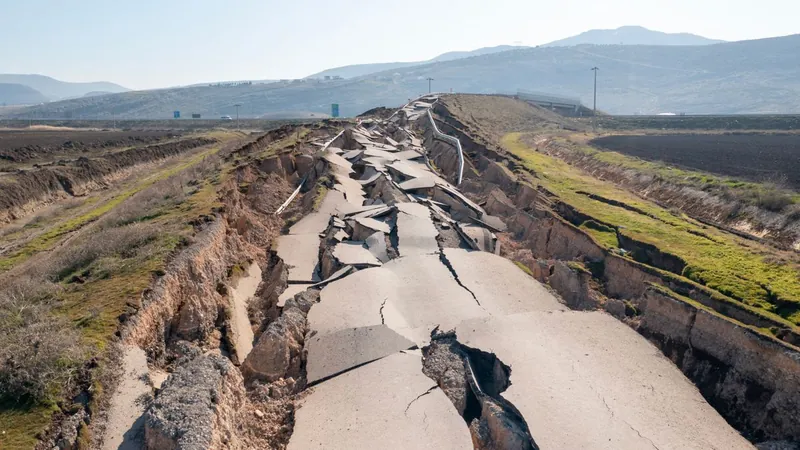
Scientists Uncover Hidden Mechanism That Could Unleash Earthquakes!
2025-01-19
Author: Sarah
Groundbreaking Study Reveals Slow Movement in Tectonic Plates
A groundbreaking study has revealed that a slow, creeping movement within tectonic plates may be the crucial precursor that triggers devastating earthquakes. This research is shedding light on the fundamental processes behind material rupture and cracking, offering potential insights into seismic events that have long baffled scientists.
Laboratory Experiments Simulate Real-World Faults
The study, conducted by physicist Jay Fineberg and his team at The Hebrew University of Jerusalem, examined the behaviour of cracks in laboratory-made sheets of thermoplastic, specifically polymethyl methacrylate, commonly known as plexiglass. The experiments simulated the conditions seen in real-world faults such as California’s infamous San Andreas Fault. Fineberg asserts that the same physical principles at play in their laboratory experiments apply directly to the mechanics of earthquakes.
Understanding Stress Accumulation in Tectonic Plates
When two tectonic plates grind against each other, they can become stuck at a fragile interface, allowing stress to accumulate over time. “As the plates are pressed against each other, they build up stress at their brittle sections, which eventually fails under the pressure,” Fineberg explained. The research shows that before a crack occurs, a slow and almost imperceptible movement takes place in what is called a “nucleation front.” These precursor cracks develop within the material but move significantly slower than what we would experience during a typical earthquake.
Nucleation Fronts and Rapid Fractures
Interestingly, the researchers discovered that when these nucleation fronts transition into rapid fractures, they can achieve speeds approaching the speed of sound, resulting in the earth-shaking we feel during seismic events. Fineberg points out that “this slow initial movement, termed 'aseismic,' does not release energy quickly enough to cause immediate quakes.”
Mathematical Modeling of Crack Dynamics
The critical breakthrough came when Fineberg's team adapted their mathematical models from one-dimensional to two-dimensional representations to better capture the complex dynamics at play. The traditional view of a crack as a simple line was expanded to envision it as a patch, with its growth directly correlating to the energy balance of the surrounding material.
The Transition from Aseismic to Seismic Motion
Once the patch extending from the brittle zone breaches the limit where energy balance is maintained, it suddenly becomes a source of excess energy capable of generating sharp cracks. This explosive shift is what ultimately leads to the tremors associated with an earthquake. Highlighting the impact of their findings, Fineberg noted that if researchers could effectively measure this slow, aseismic movement before fractures, it could potentially allow for earthquake predictions in the future.
Implications for Seismic Research and Safety
The implications of these discoveries are significant, not only for seismic research but also for ensuring the integrity of structures such as bridges and buildings that may experience similar stress reactions, averting catastrophic failures. Fineberg and his team are now focused on detecting the transition from slow, aseismic motion to the rapid, seismic activity in their laboratory settings, hoping to gain insights that could ultimately save lives in earthquake-prone regions.
Conclusion and Future Directions
This research, recently published in the prestigious journal *Nature*, is set to revolutionize our understanding of earthquake mechanics and pave the way for improved predictive measures. The findings could lead to major advancements in not just earthquake preparedness, but also in various fields where material failure is a concern. Stay tuned as we continue to follow this groundbreaking research and explore its potential impact on our safety and understanding of seismic phenomena!



 Brasil (PT)
Brasil (PT)
 Canada (EN)
Canada (EN)
 Chile (ES)
Chile (ES)
 Česko (CS)
Česko (CS)
 대한민국 (KO)
대한민국 (KO)
 España (ES)
España (ES)
 France (FR)
France (FR)
 Hong Kong (EN)
Hong Kong (EN)
 Italia (IT)
Italia (IT)
 日本 (JA)
日本 (JA)
 Magyarország (HU)
Magyarország (HU)
 Norge (NO)
Norge (NO)
 Polska (PL)
Polska (PL)
 Schweiz (DE)
Schweiz (DE)
 Singapore (EN)
Singapore (EN)
 Sverige (SV)
Sverige (SV)
 Suomi (FI)
Suomi (FI)
 Türkiye (TR)
Türkiye (TR)
 الإمارات العربية المتحدة (AR)
الإمارات العربية المتحدة (AR)